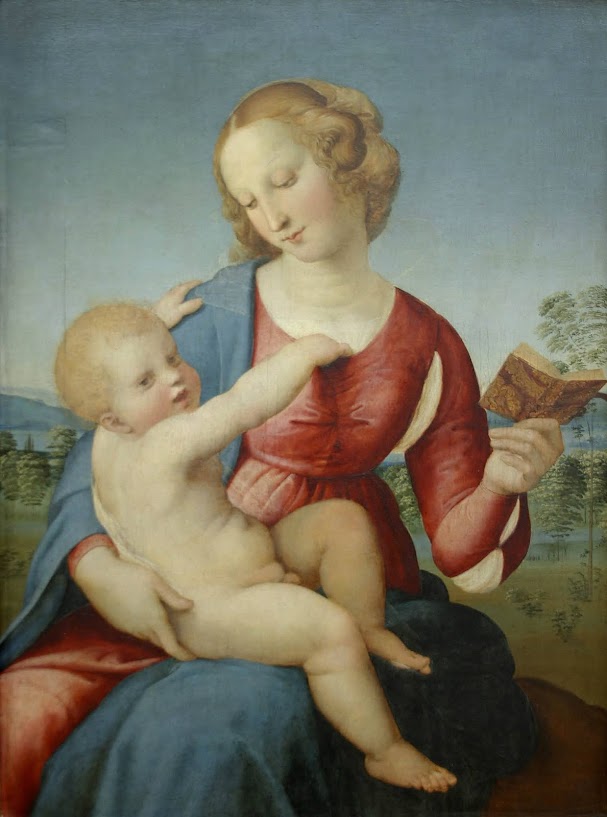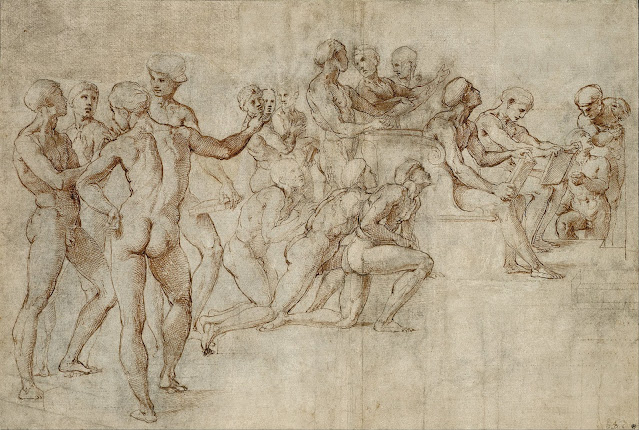For centuries Raphael has been recognised as the supreme High Renaissance painter, more versatile than Michaelangelo and more prolific than their older contemporary Leonardo. Though he died at 37, Raphael's example as a paragon of classicism dominated the academic tradition of European painting until the mid-19th century.
Raphael (Raffaello Santi) was born in Urbino where his father, Giovanni Santi, was court painter. He almost certainly began his training there and must have known works by Mantegna, Uccello, and Piero della Francesca from an early age. His earliest paintings were also greatly influenced by Purgino. From 1500 - when he became an independent master - to 1508 he worked throughout central Italy, particularly Florence, where he became a noted portraitist and painter of Madonnas.
In 1508, at the age of 25, he was called to the court of Pope Julius II to help with the redecoration of the papal apartments. In Rome he evolved as a portraitist, and became one of the greatest of all history painters.
He remained in Rome for the rest of his life and in 1514, on the death of Bramante, he was appointed architect in charge of St Peter’s.
For earlier works see parts 1 & 2 also.
This is part 3 of 5 parts on the works of Raphael:
 |
| c1505-1507 The Lamentation (Study for the Entombment of Christ) pen and brown ink over geometrical indications in blind stylus 17.9 x 20.6 cm Ashmolean Museum, University of Oxford |
 |
| c1505 Madonna and Child oil on panel 59.5 x 44 cm National Gallery of Art, Washington, DC |
 |
| c1505 Portrait of a Young Man in Red oil on panel 67.3 x 52.7 cm The J. Paul Getty Museum |
 |
| c1505 The Virgin and Child with St John (Madonna del Cardellino) pen and brown ink over blind stylus, some traces of lead or chalk 23 x 16.3 cm Ashmolean Museum, University of Oxford |
 |
| c1506-1507 The Madonna of the House of Orleans oil on panel 31 x 23 cm Musée Condé, Chantilly, France |
 |
| c1506 Saint George and the Dragon oil on panel 28.5 x 21.5 cm National Gallery of Art, Washington, DC |
 |
| 1507 La Belle Jardinière (Madonna and child with Saint John the Baptist) oil on panel 122 x 80 cm Louvre, Paris |
 |
| 1507 The Deposition oil on panel 174.5 x 178.5 cm Galleria Borghese, Rome, Italy |
 |
| c1507-1508 Colonna Madonna oil on poplar wood panel 53 x 38 cm Gemäldegalerie, Berlin |
 |
| c1507-1508 Portrait of a Young Woman oil on wood panel 64 x 48 cm Galleria Nazionale delle Marche, Urbino |
 |
| c1507 Guidobaldo da Montefeltro oil on wood panel 71 x 50 cm Uffizi Gallery, Florence, Italy |
 |
| c1507 The Infant Christ and other Studies pen and brown ink over lead-point, on white paper 28.3 x 16 cm Ashmolean Museum, University of Oxford |
 |
| 1508 Niccolini-Cowper Madonna oil on panel 80.7 x 57.5 cm National Gallery of Art, Washington, DC |
 |
| c1508-1509 Sketch for the lower left section of the "Disputa" pen and brown ink 28.2 x 41.6 cm Städel Museum |
 |
| c1508 Madonna Colonna oil on poplar wood panel 78.9 x 58.2 cm Gemäldegalerie, Staatliche Museen zu Berlin |
 |
| c1508 The Tempi Madonna oil on wood panel 75 x 51 cm Alte Pinakothek, Munich |
c1506-07 Madonna of the Pinks:
In this painting, Raphael transforms the familiar subject of the Virgin and Child into something entirely new. The figures are no longer posed stiffly and formally as in paintings by earlier artists, but display all the tender emotions one might expect between a young mother and her child. The pair are seated in a bedchamber in an Italian Renaissance palace, and exchange carnations, which are symbolic of divine love and of Christ’s Passion (his torture and crucifixion).
This small picture may have been intended to be held in the hand for prayer and contemplation. A manuscript inventory dating to the early 1520s states that it was made for ‘Maddalena degli Oddi, a nun in Perugia.
 |
| c1506-07 Madonna of the Pinks oil on yew wood panel 27.9 x 22.4 cm The National Gallery, London |
1508-1524 Raphael Rooms, Apostolic Palace, Vatican
The four Raphael Rooms (Stanze di Raffaello) form a suite of reception rooms in the Apostolic Palace, now part of the Vatican Museums in Vatican City. They are famous for their frescoes painted by Raphael and his workshop. Together with Michelangelo’s Sistine Chapel ceiling frescoes, they are the grand fresco sequences that mark the High Renaissance in Rome.
The Stanze, as they are commonly called, were originally intended as a suite of apartments for Pope Julius II. He commissioned Raphael, then a relatively young artist and his studio in 1508 or 1509 to redecorate the existing interiors of the rooms entirely. It was possibly Julius' intent to outshine the apartments of his predecessor (and rival) Pope Alexander VI, as the Stanze are directly above Alexander’s Borgia Apartment. They are on the third floor, overlooking the south side of the Belvedere Courtyard.
 |
| 1508 Ceiling of the Selling Room fresco |
 |
| 1509 Disputation of the Holy Sacrament fresco 500 x 770 cm |
 |
| 1509-1511 The Parnassus fresco 670 cm across the base |
 |
| 1511 Cardinal and Theological Virtues fresco 660 cm across the base |
 |
| 1511 The Expulsion of Heliodorus from the Temple fresco 750 cm across the base |
 |
| 1512-1514 The Mass at Bolsena fresco 660 cm across the base |
 |
| 1513-1514 Ceiling of the Room of Eliodorus fresco |
 |
| 1514 Deliverance of Saint Peter fresco 660 cm across the base |
 |
| 1514 Fire in the Borgo fresco 670 cm across the base |
 |
| 1514 The Meeting of Leo the Great and Attila fresco 500 x 750 cm |
 |
| 1514-1515 The Battle of Ostia fresco 770 cm across the base |
 |
| 1514-1515 The Coronation of Charlemagne fresco 770 cm across the base |
 |
| 1516-1517 The Oath of Leo III fresco |
 |
| 1520-15 24 The Donation of Rome fresco School of Raphael |
 |
| 1520-1524 The Baptism of Constantine fresco School of Raphael |
 |
| 1520-1524 The Battle at Pont Milvius fresco School of Raphael |
 |
| 1520-1524 Vision of the Cross fresco School of Raphael |
Lucretia:
 |
| 1508-1510 Lucretia pen and brown ink over black chalk, partially incised with a stylus 39.7 x 29.2 cm Metropolitan Museum of Art, New York |
 |
| 1509-1514 The Suicide of Lucretia, after Raphael engraving 21.2 x 13 cm Rijksmueum, Amsterdam |
 |
| c1530-1550 The Suicide of Lucretia, by a follower of Raphael oil on panel 72.9 x 51.7 cm The Courtauld, London |

No comments:
Post a Comment
Note: only a member of this blog may post a comment.